top of page
Jews came to North Africa in antiquity. Thier fortunes rose and fell under Roman, Byzantine and Moslem rule. These were old indigenous communities that interacted and borrowed from the people around them. The influx of Spanish refugees in the 15th century overwhelmed their traditions. This led to a somewhat unified 'Sephardic' prayer and other customs. Despite the nominal authority of the Ottoman Empire, colonial interests of Spain, France, Italy, and Great Britain influenced government and culture in general. The 1948 war led to great unrest and therefore emigration. Except for a small community in Morocco, there are virtually no Jews left.
Short description
North africa
 The Arab West - MaghrebThe North African countries west of Egypt were known as the Maghreb ('west'). The local population consisted of Berbers and also Arabs. Jews had lived there as early as Temple times where they worked in agriculture, livestock, and trading. This is long before the arrival of refugees from Spain, yet the influx of Sepharadim generally overwhelmed the previous culture. Iberian Jews fled from the Visigoths in the 7th century and many more came after the persecution and edicts of Catholic Spain. | 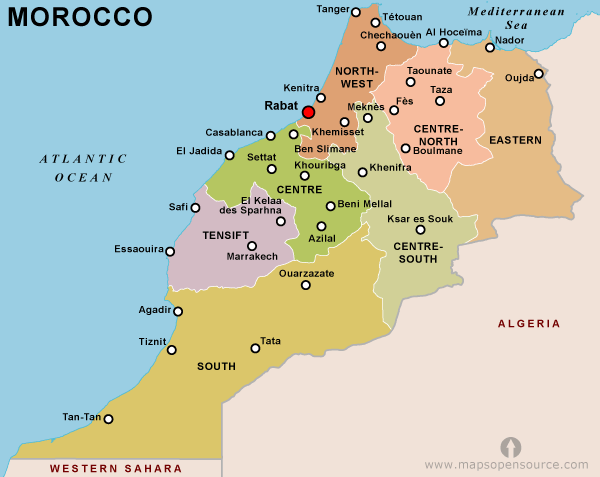 MoroccoJews lived in Fez (a Rabbinic center), Marrakech, Meknes, Tetouan, Rabat, Tangier, & 250 communities totaling 250,000 Jews. They were farmers, merchants, craftsmen, supplied caravans, and dominated the jewelry trade. Jews spoke a Judeo-Arabic dialect until Spanish and French influence made those languages dominant. Israeli independence and then Moroccan independence created positive & negative reasons to leave the country 250,000 did so between 1954 -1964. About 2,500 remain today. |  Synagogue.FezMorocco's capitol until 1925 and its 2nd largest city. Jews were welcomed to Fez from southern Spain and experienced a 'Golden age' from the 9th-11th centuries, becoming a center of Rabbinic and literary scholarship. R' Yitzchak 'alFASi' was from here and Maimonides compiled his commentary on Mishna here before escaping to Egypt due to Moslem extremists. This is a model of the Danan synagogue in 17th century Fez. |
|---|---|---|
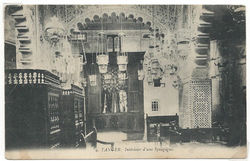 Synagogue.TangierOver the centuries Jews have come and gone from Tangier numerous times. The community was revived in the 1700's and there were 10,000 living there in the 1920's when it was an international zone. Annexation by Morocco after gaining independence led to mass emigration. There is a 'Street of Synagogues' but only one is open now. This (unknown) one shows tiles walls, curved arches and hanging lamps, all Sephardic / Middle Eastern features. |  Fez.synagogueThis early 20th century postcard shows a scene of the 'Interior of a Synagogue' in Fez. It doesn't say which one. We can see decorated walls and pillars, hanging lamps, and typical Sephardic wooden seating, with benches in every direction. It does not look like the restored ibn Danan synagogue. The internet mentions 2 synagogues in the Fez mellah that are being restored.... |  Rabbis clothingMorocco produced many well-known rabbinic families including Abuhatseira, Ibn Danan and Pinto. Pictured here are 2 20th-century rabbis in traditional clothing. The caps are taller, the sleeves are wider, and their robes ('burnoose') are folded on top to show the decorated lining that they were permitted to wear. The burnoose would have a distinctive red mark. Sometimes a navy kerchief would be wound around the cap. |
 Rabbinic Court.MogadorYoung people coming to a new community had to establish their status, particularly if they intended to marry. This document declares that Shelomo son of R. Masoud was carefully examined by a 3-Rabbi court which heard testimony about him and declares him to be single. Dated 30 Adar I 5673 (1913) in 'Itzvira' , another name for Mogador, Morocco. Signed by several rabbis including R; Yosef ben Attar, head of the Beit Din. It is written in Sepharadi 'Solotreo' script. | 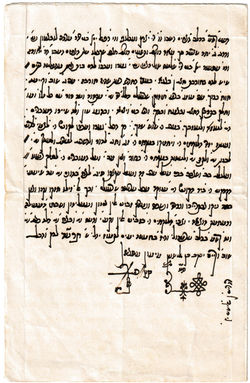 Rabbinic Court.SefrouThis rabbinic document validates a sale of property between Labaton and Toledano families in Sefrou, Morocco in 1914. Signed by R' Yaakov ben Elisha Maimon Mashash. Jews had lived in Sefrou for centuries peaking at 8000. The 1948 to 1967 conflicts drastically reduced their numbers. |  Chief RabbiR' Shalom Mashash was appointed chief rabbi of Casablanca in 1949 and later chief rabbi of all Morocco. in 1978 he came to Jerusalem to be its chief Sephardic rabbi and head of Beit Din for the next 25 years. Known as a child Torah genius, he published many books. This letter to the U.S. accompanied a Get - a Jewish document of divorce. |
 CHANGE PHOTO.Rabbinic Court JudgementR' Yaakov Mashash signed this rabbinic judgement in Sefrou Morocco in 1914. It adjudicates ownership of properties that have been sold. Written in flowing but hard to read Soletreo. The trademark decorative signature at the bottom reads 'Yaakov ben Elisha Maimon'. Mashash. Sefrou had anancient Jewish community, still vibrant until the conflicts of the 1940s. |  Jewish Court MogadorThe French took control of Morocco as a 'Protectorate' in 1912 (until independence in 1956). The government was weak and they wanted to preserve order and investments from abroad. This envelope is from the official stationery of the Jewish court, Beit Din, in Mogador. The community was famous for its religious poetry and illuminated ketubot. The Jews all left for Israel, France, or Canada in the 1950's. |  Tangier.court stampsTangier was at the tip of Morocco and just across the water from Spain. Jews there felt closer to Spanish culture than to the French influence of the Protectorate. These stamps aren't for postage but for paying court fees on documents. They read in Hebrew 'Holy Community of Tangier May G-d Protect Us'. Below the symbols of scales and 10 commandments is the denomination, which is Spanish - centimos and pesetas. |
 Morning prayersThis Moroccan is dressed for morning prayers - Shacharit. His Talit is worn Sephardic style, around the body instead of folded over the shoulders. The Tefillin on his left hand are wrapped in the Sephardic style as well. |  Bar Mitzvah.Talit.BookstoreIsaac Melloul's Hebrew bookstore in Fez also sells Judaica supplies. Here is advertised the newest Talit, suitable for Bar Mitzvah or wedding. 'The woven blessing covers the whole surface of the Talit.' |  Challah ticket.FezCharitable societies were organized to help the needy. This one in Fez was called 'Hevrat Hessed Ve'Emet' (Kindness & Truth). Their activities could include burial service, making weddings, visiting the sick, and assisting the poor. This ticket, in Arabic, French, and Hebrew, could be exchanged for Hallah on Erev Shabbat. |
 Passover CharityThis receipt is for a donation to the Hevrat Gomlei Hassadim, that is the Society of Charitable Doers. lt is dated 1950 in Fes. Yaakov Simhon gave 500 Francs 'On the occasion of the holiday of 'Paque''. Paque actually means Easter, but that is the closest word French had for Passover. Two tax stamps are attached and stamped with the society's seal. |  Wedding.RabatThis couple is getting married. They are dressed in traditional wedding clothes. The bride is draped and wearing jewelry on neck arms and fingers. She is wearing the traditional 'Grand Costume' with its symbolism of fertility and blessing. And her face and hands are decorated with Henna. The Chatan's outfit is quieter but formal. |  Cemetery.Fez MellahA Morrocan proverb states 'Death within the family is a joy', meaning that it is a privilege to die among one's family and for the family to receive the blessings and perform the final Mitzvot for their loved one. The cemetery was inside the Jewish Quarter of town (Mellah) as shown in this scene. |
 Funeral.MogadorMoroccan funeral customs include: A person dying at home would wash his hands and put on his Talit. The family would approach to receive a blessing. Candles would be lit around the room. After death, a window would be opened briefly 'to allow the soul to depart'. Symbolic gestures representing the 4 types of Jewish capital punishment are meant to save the soul from suffering. | 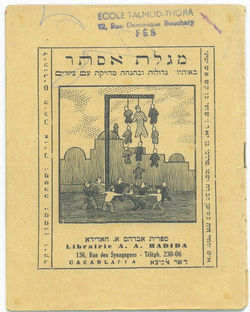 Schoolbook.printingIn 1959 there were over 30,000 students in Jewish schools. This booklet of Megilat Esther was printed for the students of the Talmud Torah School in Fez. It was supplied by Hadida's Jewish bookstore in Casablanca and printed there. |  Boys' clothingThis young man wears a flowing burnoose, a long woolen cloak. This was a typical North African style of clothing. And a large cap set back on his head. |
 Boys Dressing UpThese young men are posing in a studio in Casablanca. They are wearing dressy outfits. Their pants just reach their boots, their tops are fancy, and they wear matching jackets. |  Women's Clothing.indoorWomen's indoor clothing could be colorful and elaborate. In public, modesty, restrictions, and prudence called for simple cloaks. |  Tin-Mel.WomenThese women are from Tin-Mel in the Atlas mountains of Morocco. They are wearing dresses with attractive prints, probably imported from Europe. However, all have wrapped and pinned white robes over their dresses. They are wearing jewelry and coins as necklaces and bracelets. Most interesting are their headdresses, indicating their married status. Those are quite elaborate productions consisting of kerchiefs, tassels, pieces of silk and false hair, all intertwined. |
 Adult Clothing |  Tangier.festive dressThe festive dress in communities of Spanish origin preserved elements of 16th century Spanish costume long after expulsion. It consisted of a tight-fitting short-sleeved jacket cut low in the front into which an embroidered panel was fitted. It was made of dark-colored velvet with heavy metal thread or braid attached. Wide flowing sleeves began well above the elbow with a wide stiff brocade sash wrapped around the waist. A velvet skirt, along with head scarf and jewelry completed the outfit. |  Album.World of S.Libya.Jewish community. |
 Album.World of S.Libya.Tripo |  Tangier. Grand CostumeThese women are wearing 'El Keswa El Kabira' = The Grand Costume, reserved for weddings and special occasions, but only in private. It is made of velvet with gold braid. The embroidery is symbolic: concentric curves rising from the hem represent fertility while the 7 silver jacket buttons signify the Sheva Berachot. |  Mellah.FezThe Mellah was a designated Jewish quarter of the city, with walls and gates. It started out as a protected area but came to be a kind of Ghetto. They became overpopulated and poor. Here is a post card and a stamp. Both are marked Fes Mellah Morocco, showing that they were mailed in the Mellah. The postcard was mailed from a German local post office; the stamp was mailed from a French local post office. |
 Mellah.marketIn the Mellah, Jews are walking the streets or just watching people go by. In the market, Jews are buyers and sellers. We can identify them by their beards, Peyot and large Kippot. |  Fez.main street of MellahThis is the main street, and perhaps business district, of the Mellah in Fez. The postcard was sent by a traveler back home to Switzerland. |  Mogador.Street of MellahThis is the Street of the Mellah in the Jewish Quarter of Mogador. We can't tell from the outside how nice the homes may be inside, or if one of the buildings is a synagogue or school. Jews were recruited in the 1700's to help develop trade in Mogador. It was at one time Morocco's most important commercial seaport. That has declined and the Jews are gone. |
 Marakesh.Jewish market squareHere we see the market square in the Mellah of Marrakech. Visible are people, animals, wagons and goods. This was the shopping center of the Jewish district. It was also a place to socialize and hear news. |  Wealthy Home. FezEven in the Mellah, there were streets with lavish homes of well-to-do families. The rooms are spacious, there are cushions for sitting and hanging laps for illumination. Every surface is decorated with beautiful tiles. |  Wealthy homeNot every Jew lived like this but for those who could afford it, homes could be spacious and ornately decorated. Notice that the designs are all geometric patterns. This imitates the Moslem custom of avoiding images of people or animals. That rule first appeared in the Torah but in many periods and places Moslems have followed it much more strictly. |
 Morocco.Fez.lavish home interior |  Mellah.CasablancaThese Jews lived in the Mellah Casablanca. All but 2 seem elderly and use a walking stick. All are wearing the dark burnoose/cloak over their clothes. The two middle men, one standing one sitting, seem to be wearing Tefillin - unless they are blessed with a lot of dark hair in their old age. Wearing Tefillin after prayer was a sign of extra piety but was usually only seen in the synagogue or study hall. |  Craftsman.MetalworkJews worked in crafts and trades. This older man is focused on his craft of metal work. It looks like he is punch-engraving a design. |
 Craftsman.ShoemakerElderly, but not too old to work. This craftsman is a shoemaker. | 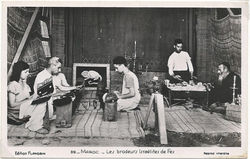 Embroiderers.FezMorocco's cities have been famous for their embroidery for centuries with Jews playing a significant role. This embroidery shop is a family business with an older Jew on the right in traditional clothing and younger head-covering members of the family busy at work. Tools and equipment are all around. The woman on the left seems to be doing her work by hand with needle and thread. |  Druggist.CasablancaAlready in the middle ages Jews were prominent physicians, pharmacists, drug sellers and potion- makers. In the modern age, when medicine is science-based and drugs are produced by companies in factories, the reliance on ethnic and folk-remedies has greatly declined. This man was a Jewish seller of folk-remedies and potions in Casablanca. Notice how he stores his inventory. |
 Merchant.TangierThe Benchimols were international merchants in Tangier going back to the 1700's. Their activities included diplomacy, banking, newspaper publishing and philanthropy. This envelope mentions 'The Ancient House of Benchimol', after their founder, and then the current owner Moses Benchimol of Tangier. Notice that the stamps used to mail this envelope are Spanish, overprinted 'Marrueccos' since Spain controlled this northern tip of Morocco until 1956. |  Rabat.Men PicnicThese men have gone out to the fields for a picnic. They are smoking, drinking coffee and tea, and some are holding musical instruments. Their clothing is that of the city-folk: a high-necked tunic, covered by a robe and encircled with a sash. They each wear a rather high round cap on the back of the head. |  Fez.After Bombardment.1912Events of 17-19 April 1912. When the French took control of Morocco in 1912, a revolt broke out in Fez, objecting to the takeover. Local soldiers mutinied and the French fought back with artillery. Riots were directed at Europeans and Jews, killing several dozens and destroying homes. The revolt devastated the Mellah and its 12,000 Jews. |
 Fez.pogrom.searching ruinsAfter the riots ended, Jews returned to the rubble that was their homes, to search for personal belongings. | 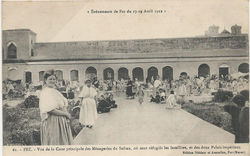 Fez.Sultan's refugeAfter the riots, many Jews had nowhere to go. The Sultan Yusef opened his palace to these Jewish refugees. Here we see them safely walking and sitting on the palace grounds in front of the zoo. |  Fez.Sultans refuge.ZOOUp close, we see a startling sight: Jews have moved in to vacant animal cages! In the left cage are lions; in the right one are Jewish families and their belongings! |
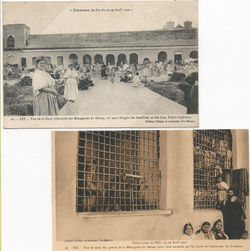 Fez.Sultan's protection | 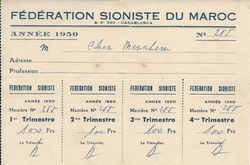 Zionism.CasablancaEarly Zionism in Morocco was mainly concerned with sending money to support the growing Yishuv in Palestine. Menachem Cohen is a supporter. Here he pays his dues to the Zionist Federation of Morocco. He gives 100 francs every three months in 1950. | 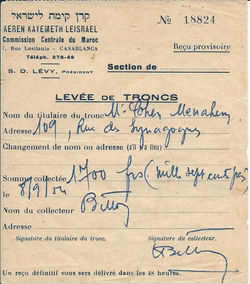 Casablanca.JNFMenachem Cohen is also a supporter of the Jewish National Fund in Israel which deals with forestation and water reclamation. In 1954, he donated 1,700 francs to the JNF. One wonders if he was among the tens of thousands who made Aliyah from Morocco in the 1950's and 60's. |
 ZionistsThese merchants sit in front of their store. Their Fezes date them to the Ottoman period. The Star of David with 'Tziyon' written inside in Hebrew declares their Zionism. |  Aliyah to Palestine.1922This Jew did make Aiyah, back in 1922. He is Abraham Massasse, a jeweler from Fez. |  Passport.description & photoHere Abraham is pictured with one of his daughters. Perhaps the other child is pictured with his wife on another document? He is described as 60, with gray everything, a moderate mouth and big nose. Her name is not recorded. |
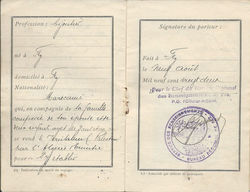 Passport.aliyahAbraham is listed as a jeweler from Fez, traveling with his wife and two children. His destination is Jerusalem, Palestine, and he intends to settle there. |  Passport.Aliyah VisaAbraham obtained a visa from the British Vice Consulate in FEz, permitting him to enter Palestine. He landed in Aleandria Egypt on November 2nd and reached Palestine on November 10th, 1922. |  Morocco.passport.Fr Protectoaliyah 5Morocco's government was unstable so France and Germany intervened to protect their financial and political interests. From 1912 -1956 Morocco was a French 'Protectorate' with much influence in the country and much development of infrastructure. So they were the issuers of this Moroccan passport which reads "Moorish Empire French Protectorate". |
 Casablanca.Court testimony.maleIndividuals who traveled needed to establish their religious status in order to successfully join the new community. Amram Shoshan obtained this document from the Beit Din in Casablanca. It declares that he, the son of Yamin Shoshan and Pricha Melul has never married (and so is an eligible bachelor). Signed on 26 October 1961 by R' Shalom Mashash and R' Aberzil. |  Casablanca.Court.WomanThis document establishes the I.D. of the woman Izza Benabou, daughter of Judah Benabou and Simcha Malka. She is the wife of Rabbi Maklouf Soussan living in Casablanca. So declared on 2 March 1960. In this case, the document was officially translated into French and the documentary tax paid. We see seals of the Beit Din and of the government registry. The photo shows this 'Rubisa' dressed very modestly. | 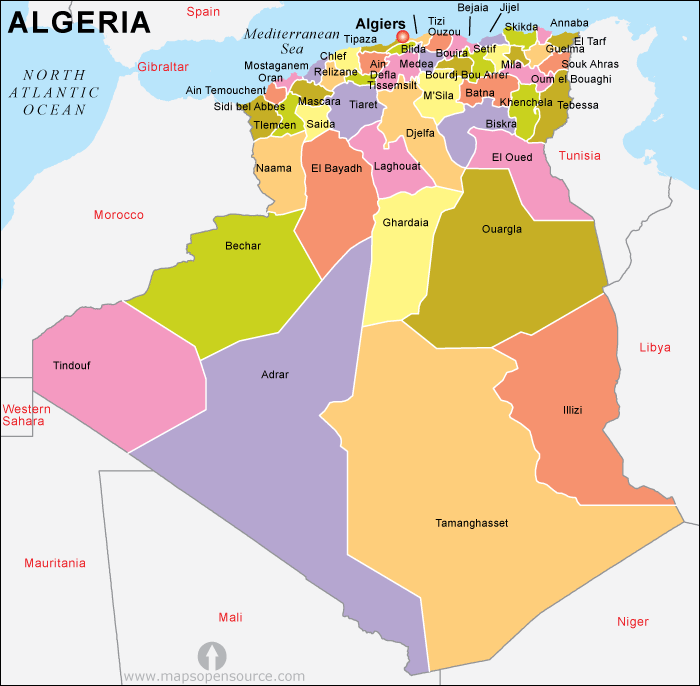 AlgeriaJews moved to Algeria in the 7th century, following conquering Arabs, and rebuilt ancient Jewish communities. Fortunes rose and fell under Moslem rulers. Spanish refugees began arriving in 1391, overwhelming the local culture but strengthening Jewish life with their intellectual, financial, and Torah skills. They became important in diplomacy and commerce. Unrest over independence in 1962 shrank the Jewish population from 140,000 to 1,000 and all 60 synagogues were converted to mosques. |
 Oran synagogue.exteriorJews dominated this west Algerian seaport back to the 1300's but suffered many hardships. The community included Spanish refugees and other North African Jews speaking Hakita and Judeo-Arabic. The French dominated after 1830. |  Oran synagogue.interiorThe interior is spacious and arranged in typical Sephardic style. Behind is the women's balcony above Moorish arches. This great synagogue was dedicated in 1918 but the anti-Semitic violence brought on by the Algerian struggle for independence forced the Jews to leave by 1963. This building was converted into a mosque in 1975. |  Algiers.synagogueThis is the Great Synagogue of Randon Square in the capital city of Algiers, as it looked in 1902. In December 1960 it was attacked by a mob and Torah scrolls were desecrated. Once Jews left the city, it was converted into a mosque. |
 Setif. synagogueSetif is a provincial town in Northern Algeria. The massacres at Setif in 1945 marked the beginning of the Algerian War of Independence and the Jews left. Typical Sephardic seating along the walls can be seen This photo was taken from the women's balcony. |  Boghari.synagogueBoghari is another way of saying Bukharian. Grenades were thrown at this synagogue in 1958. |  Constantine SynagogueThis was known as the 'Gozlan Synagogue. It is the building in the center at the back of the square. |
 Chief RabbiThis envelope mailed from France in 1872, is addressed to M. Charleville, Grand Rabbi of the Jewish 'consistoire' at Oran. A consistory is council of Jews that represents the Jewish community to the government and manages Jewish life. Established in France by Napoleon, this system was applied to Algeria. Rabbi Mayer Charleville had been rabbi in Dijon and Versailles (France) before being appointed Head of the Jewish community in Algeria. |  Rabbi.ConstantineR' Jacob Vaknine was rabbi in Constantine Algeria before moving to Corsica. Here he is writing to his son Yehuda who lives in Alexandria Egypt. The language is Hebrew and the script is 'Soletreo', a Sephardic script used mostly among Turkish and Greek Jews, often for writing Ladino. |  Rabbi writes to Son in EgyptThe son's name is Yehudah . Since he was a first born, the name 'Bchor' is added. The name Yehudah is written carefully -yud ALEF vav dalet hay, to avoid writing the first 3 letters of G-d's name. The last 2 letters on the card, following the rabbi's signature, are Samech Tet which could stand for Siman Tov or Sefaradi Tahor. |
 Siddur.ConstantineThis siddur was printed in Constantine, Algeria. It is a Hebrew/French edition with the translation (and other comments) on facing pages. The publisher is Daniel Renassia, who is described as Rabbi and Mohel at 'Or Torah' (synagogue?). There is no date given, but a Chumash is known to to have been published by him in 1940. |  Bible Commentary"Shir Ben David" - a commentary on Shir Hashirim (Song of Songs) in Hebrew and Judeo-Arabic by Rabbi Yosef Ben-David Renassia, 15 Grand Street, in Constantine, Algeria. This book was written by an Algerian rabbi. It was printed in the quite religious community of Djerba, Tunisia, in 1953. The book is named for the author and the description is in French. |  Rabbi's Tomb.TlemcenGraves of rabbis are places to visit and pray. This postcard pictures the grave of R' Encaoua. If the dates on the card are correct, this might be R' Ephraim b. Yisrael Encaoua who came from Spain and died in 1448. Numerous descendants from this family were Algerian rabbis after him. He is buried in the Tlemcen Jewish cemetery. Reverence for tombs was strong in Moslem culture and had an effect on Jews in Moslem countries. |
 Religious school donationThis is an official receipt for a 100 franc donation to the 'Midrash' the religious school made in 1890. This was before the modernizing Alliance Israelite Universelle school opened in 1902. The language of the document is Judeo-Arabic, printed in Hebrew letters. (In Arabic, the word for such a school is 'Madras'!) The round seal says (in French) "Jewish District in Constantine, Patriotism, Religion". |  Rabbi Sends Divorce BillChief Rabbi of Algeria, Maurice Eisenbeth writes to the Sephardic chief rabbi of Haifa in 1937. "Following the request of the widow Esther Moreno, living in Haifa, I am sending you the Get along with accompanying documents. Please let me know when she receives it...." Stamps of the Rabbinical Court and Chief Rabbi of Algiers |  Children.ConstantineThe caption of this card reads "Arab street, Jewish children". Her dress is long and flowing, his pants are appropriately baggy and end at the shins. He has solid leather shoes while she seems barefoot. Everybody has a head covering. |
 Jewish girls.ConstantineJewish girls ranging in age from perhaps 5 years old up to adult. Is she the mother? Constantine was a major Jewish center in the area, boasting numerous scholars and poets. |  Jewish & Arab childrenThe caption on this card reads "Arab & Jewish children". Can you tell which is which? The clothes are simple. Both boys and girls wear long garments. Notice that nobody is wearing shoes but everybody's head is covered, with either a hat, a cap, or a scarf. | 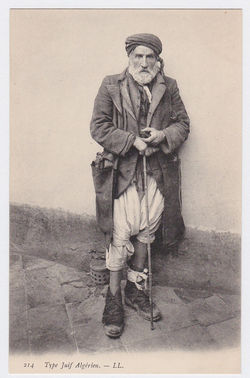 Algeria.man.clothingThis man is wearing a shirt, vest, coat and overcoat. Most distinctive are his turban and his baggy but short trousers. These were traditional and more modest than western, form-fitting trousers. |
 Algeria.old manShirt sleeves and a vest, but quite a full turban. This card was mailed from Algiers to France in 1910. No message, just the exotic image. |  Jewish wifeAlthough in this posed picture the woman has her scarf over her face, that is not required indoors. We see a sleeveless blouse over a long-sleeved shell and flowing pantaloons - and she is definitely indoors. Street clothing would require robes and much more covering of the body. |  Young Jewess Dressed UpScarf, earrings, necklace, headband, and beautiful sash at the waist. |
 Woman Dressed UpThis woman's head is completely covered, including a conical hat at the back. Coins hanging from necklaces are a show of wealth - and perhaps even a dowry! |  Constantine.Jewish quarterAlgerian Jews acquired French citizenship in 1870. They called their district 'The Jewish Quarter' in French rather than the Arabic 'Mellah'. This postcard showing a view of the Jewish Quarter was published well before the pogrom of August 1934 which killed or wounded hundreds of Jews and destroyed half of their district. |  Jewelers.ConstantineA jewelry shop displaying some wares. Moslems were happy to leave jewelry making to Jews because they believed it fell into a forbidden category of work, related to usury. Jews in turn learned valuable and transferable skills. Look at their expressions. |
 CobblersA lowly profession, conducted in a tent. But everyone seems happy! |  Carpet merchantThis man walks the streets selling carpets. It's not clear what the binoculars are for. He is wearing classic male clothes for the region: a turban with a tassel, 'sarwal' (pantaloons) probably fastened by a girdle (izam), and perhaps a practical jacket instead of the more traditional robes and mantles. |  Camp Djelfa.backIn 1940, French controlled North Africa came under Vichy (pro-Nazi) control and the anti-Jewish laws of Europe were applied. They lost citizenship, property, public positions, employment. Dozens of labor camps were created in which internees worked long hours in unbearable heat. Djelfa in Algeria was the largest. |
 Camp Djelfa.frontMathew Katz, one of 4,000 inmates, is interned in Djelfa. He is writing to the the Red Cross in Geneva, Switzerland.The envelope shows the Djelfa return address, the Djelfa censorship mark and the postmark of 14 April 1942. Internees did not have to use stamps. |  Algerian Jews support ZionismA Shekel receipt for membership in the World Zionist Organization - printed in the upper right corner ‘Algeria’ in Hebrew. Dated 29 April 1946. The donor is Madam Souha daughter of (A)braham Partouche from the Algerian city of Ghardaia. After Independence, Algeria declared that only Moslems could be citizens. Jews had been in Algeria since the 1st century. About 130,000 Algerian Jews (95%) left the country, and went to France. Since 1948, around 25,000 Jews have moved to Israel. | 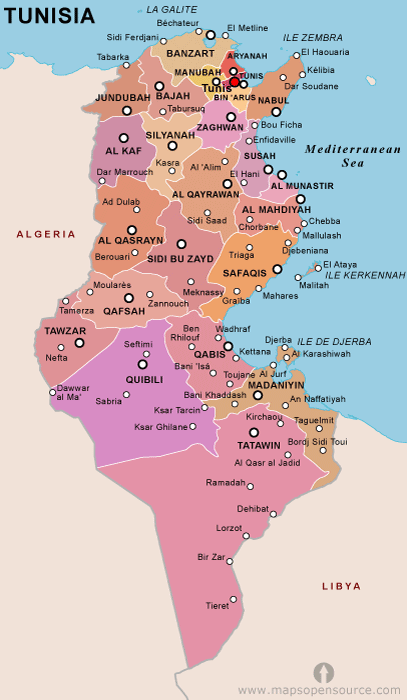 Tunisia.mapAncient Jewish communities were lost to conquest & forced conversion. From the 17th century Tunisia again became a center of Jewish learning. They were scholars. merchants, bankers,craftsmen; Jews had the monopoly on ostrich feathers! In 1881 France established a protectorate, which led to French citizenship. Vichy French brought discriminatory laws to Tunisia in 1940, followed by the Nazis. After independence in 1956 Tunisia underwent Arabization and Jews suffered and began to leave. |
 Tunis.Great SynagogueWhen the Jews of Tunis left the ghetto after WWI, they built a new 'great' synagogue in the European quarter, completed in 1937. It was a Nazi warehouse in WWII and ruined again after the 6 Day War. The government helped with restoration but by then most Jews had begun to emigrate. Today only about 1000 remain. |  Tunis.synagogue stampThe great synagogue of Tunis was featured on an Israeli stamp in 1970, one of a set of five. It aroused controversy in religious circles since it portrays accurately the four-letter Hebrew name of G-d in the Magen David above the entrance. Cancelling the stamp, or throwing the envelope in the garbage would desecrate G-d's name. In fact, this example shows the cancellation blotting out the Name on the stamp. As a result, the government withdrew the set after only 3 months of sale. | 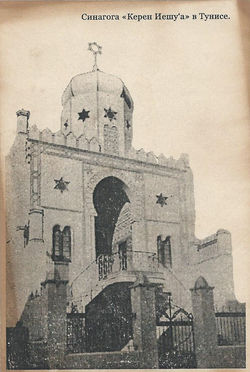 Synagogue.La MarsaThis synagogue stands in a suburb of Tunis, 'La Marsa'. Built in 1927 in the Moorish style, its exterior is painted blue and white, like some other buildings in town. Furnished Sephardic style, its unusual Teva is circular, with a dome on top. Among the decorations is a blessing for the leaders Tunisia, engraved in marble in Hebrew, Arabic, and French. The synagogue serves a small Jewish population and is a popular tourist spot. |
 SynagogueImage of a painting signed '1913 Tunis'. However it does not identify the synagogue. The pillars & round arches are typical of N. African synagogues, showing Arab influence. The seats are not chairs but rather long benches with backs, located against the Bima from which the Torah is read. (There would be more of them around the perimeter.) The men are wearing robes, turbans & talitot. 2 are standing at the Bima, one reading & another reciting the blessings, an upright Torah before them. |  Synagogue.DjerbaThe Ghriba ('extraordinary') synagogue, on the Island of Djerba, is named for the legend that within it is concealed one of the gates of the Second Temple, brought there by escaping Kohanim. It has been a center of pilgrimage until today. The arches and tiles are typical. The seats face in every direction. |  Djerba synagogue 2Another view. The community, numbering about 1000, has an unusually high percentage of Kohanim. The synagogue is said to have been in continuous use for some 2000 years. |
 Synagogue.Djerba Bimah |  Djerba. synagogue ArkThe Ark is open for this picture. The Torah is housed in a typical cylindrical case, with 2 silver Rimonim on top. Also on display are numerous dedication plates and amulets. |  Chief Rabbi HalfonCommemorating R' Moshe Halfon Hakohen. 1874 - 1950. The back describes him as 'Chief Rabbi of Southern Tunisia'. He had been a Dayan, religious judge, in Djerba in the North. He wrote a history of Djerba, a book of its customs, and a book of responsa. He was a signer of the document banning the secular Alliance school in Djerba. |
 R' Rahamim HavitaRabbi Rahamim Hai Hawita Hacohen (1900-1959) was born on the isle of Jerba. He was a student of R’ Moshe Kalfon Hacohen, the Av Beth Din of Jerba. He was named Shochet of Jerba and Sofer of the Beth Din. He wrote books of Halacha and was a sought after speaker. When Rabbi Moshe Kalfon Hacohen passed away, Rabbi Rahamim replaced him as Rosh Av Beth Din for 4 until he left for the Land of Israel. Rabbi Rahamim settled in the community of Berechia. He was respectfully named HaAdmor MiJerba. |  Old RabbiHe wears typical turban and robe. |  RabbiThis picture shows the typical short pants and leggings. |
 Rabbi.GraibaThis card was mailed from Graiba, in central Tunisia. The Rabbi is wearing distinctive rabbinical clothing that would be recognized all over the Middle East. That is, the striped caftan and sash around the middle. Sepharadim in Palestine wore the same and it was even adopted by certain Ashkenazim in Jerusalem. |  Rabbi correspondanceR' Havita di Hanina Hakohen writes to R' Katz, Ashkenazic chief rabbi of Cairo. He was recently married, would like to open a store for religious articles. Could the rabbi put him in touch with a supplier? Dated 1920, he signs as the sofer of the beit din in Djerba. The writing is typical Sephardic cursive, often called 'Rashi' script, used throughout the Middle East. | 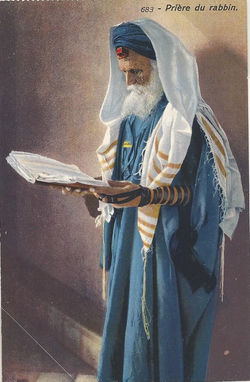 Rabbi at prayerThis picture may be posed but it still represents a long tradition of rabbis and observant Jews in Tunisia. Note how the Tefillin are portrayed: His Shel Rosh is at the top of the forehead, pushing back the purple turban, which covers the straps. The 'retsuot' (straps) of the shel yad are wound in the distinctive Sephardic fashion. |
 Elder prayingHe wears the burnoose type robe with the hood. We see a cap with no turban, beard and peyot. | 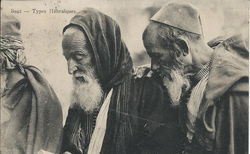 Elders at prayerRobes, caps, and hoods. beards and sidecurls ('peyot'). |  SiddurThis siddur includes services for Shabbat and holidays. "...according to the custom of Sephardic congregations that are in Eastern lands". Pocket sized but with large letters. Published in 1946 on Djerba where David Idhan established a Hebrew printing press in 1906. He continued publishing until 1960 by which time most Jews had left. |
 Birkat Milah.CircumcisionThis scene records a circumcision, which Sepharadim call Birkat Milah. There is an interesting mix of traditional and modern clothing. Perhaps the Mohel is also a doctor, dressing professionally. The Sandak wears a fez. |  Jewish school.girlsThe caption reads in French 'Jewish School', but gives us no name or location. The card was mailed from Tunis. This is likely a traditional school and not one of the Alliance chain, which were more westernized. Here we see an all-girls class, wearing the uniform of the imposed dress-code. |  WeddingThe bride wears the 'Jewish' clothes of Tunisia although the gold brocade must be special for weddings. Symbols for good luck abound: Hamsa, amulets, henna, eggs. Going to the mIkveh was a special event. The ceremony took place in the brides home. Then all would go to the groom's home to read the Ketubah and recite Sheva Berachot. Festivities continued for the next 5 weeks. |
 Bride's costumeA closer look at a bride shows the brocade, the leggings, and the distinctive velvet hat. She wears jewelry and her hands show marks of henna. Mailed in 1909. |  Ketuba.Marriage ContractMarriage contract - Ketubah - dated in Jewish, Moslem, and Christian dates as 5703 (1362,1943) written in Soletreo on French Protectorate taxed paper and recorded by the Rabbinic Court of Tunis. In the city of Sfax, a Mediterranean port. Yosi ben Sasi marries .... Attia. The text is generally standard. |  CemeteryThis scene takes place at the cemetery, outside the city walls. The tombs are built of brick and mortar and lie flat, which makes them less vulnerable to damage. The women are sitting right on the slabs and must be observing a special anniversary or similar occasion. |
 Women.outdoor clothingOutdoors, and especially outside the Jewish Quarter, Jewish women wore the clothing that the Moslem government imposed upon them. The pantaloons and leggings are visible, and we can assume the pointed hats. Everything is draped in flowing robes. This postcard was colorized to make it more attractive to tourists. The actual colors were probably not so bright and flashy. |  Out for a walkA Jewish family goes for a walk wearing their outdoor clothes. | 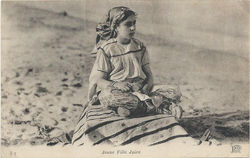 Girl at the beachThis young Jewish girl wears a long top, printed flowing pantaloons, high striped stockings or tights, and a full scarf on her head. She is at the beach, sitting on a blanket over a box, gazing out to sea. |
 Jewish childThis boy has beautiful clothes and an interesting hat with tassels hanging down. This card was mailed from Kairouan, which was a world center of Jewish scholarship for several centuries, until the community was forced to break up and leave in 1270. Mailed in 1915. |  Young womanThe young women is posing for a picture in front of a backdrop. She looks quite dressed up with her jewelry, flowery pantaloons, and dressy shoes. The card was mailed in 1907. |  Mother & childrenMother and daughters are standing in front of their home. They are all wearing scarves - but two of the kids are barefoot. This card was mailed in 1902. |
 Family at homeHere is an extended family in front of their home. It looks like several generations are included. The women's pointed hats identify them as Tunisian. |  Home.SimpleInside a home, with parents at work and children playing. In Tunis, the Jewish Quarter was called the 'Hara'. Jews originally gathered there for protection, but then waited centuries for permission to live outside. The homes eventually deteriorated and were all demolished in the 1960's. |  Home.fancyDressed in typical but fancy clothing, this woman's home seems more luxurious. Tapestries, bedding, inlaid furniture, and decorated serving ware. |
 Tozeur.LaundryTozeur is an oasis and city in southwest Tunisia. Here women have brought their laundry to the river for washing. They do the actual scrubbing in shallow metal tubs. One is being used in the middle of the picture. Another is on the head of its owner. Every woman is wearing a long dark cloak with hood, although the sleeves have been pushed up so as not to get soaked. | 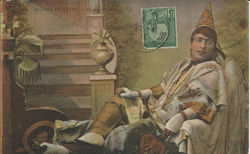 SingerThe caption reads 'Jewish singer'. She is dressed beautifully, in clothes we recognize. The backdrop seems artificial, in a studio. This card was mailed from Tunis in 1911. |  Tunis.merchantThe return address of this business envelope reflects the livelihood of Tunisian Jews for many centuries. Smadja & Cohen are involved in trade, import and export, and can represent clients in buying and selling. Jews in the Smadja family were leaders in the underground resistance against Nazis in WWII. Henri Smadja received several medals for his bravery. |
 Money changerMoney changers performed a vital service for people traveling abroad. Today we call it 'foreign exchange'. Jews were frequently involved in it because of business sense, knowledge of languages and foreign connections. It was a portable business that could be moved easily. Judging by this man's clothing, he is successful. The purple turban is typical of Tunisia. |  Zionist ActivityZionist activity flourished in Tunisia by the 1920's. Revisionists (Betar) and Socialists (Hashomer Hatzair) brought ideology to the communities and also helped it to organize against anti-Semitism. This membership card is for the Religious Mizrachi party. Their slogan was Torah Va'avodah - Torah-life and labor. We read "Purify your life with labor and sanctify it with Torah". |  Zionist MembershipAbraham Halimi is pictured on his membership card. He was 34 when he became a member, right after WWII. He was a tailor by profession. Association with these groups probably made immigration to Israel logical and relatively smooth, once Jews began to leave Tunisia. |
 New.Seperate.Zionism.Sfax | ![Libya map.[1]](https://static.wixstatic.com/media/ba481d_53b42ce4a1fa4ee9a075844fb1fcf90a~mv2.gif) Libya map.[1] | 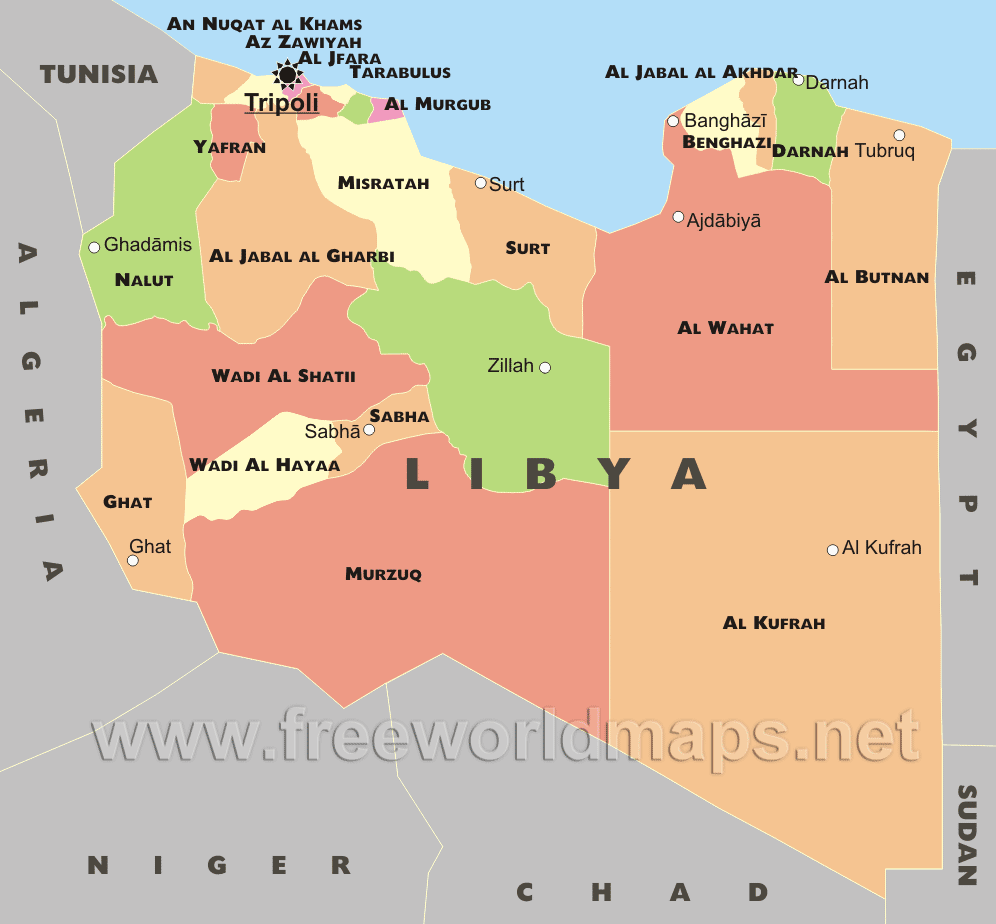 Libya map.2Jews lived in Libya in antiquity. More is known about them in the Ottoman period. There were synagogues and Jewish courts. Jews, mostly poor, were artisans, merchants, peddlers, and farmers. Jews indentified with Italy after its conquest in 1912. It became a battleground in WWII between the Germans and the British, and Jews suffered. The Jewish Brigade helped but riots ensued. Numbering 40,000 at their peak, Jews left for Italy and Israel and none remain today. |
 Synagogue.ZlitenZliten lies 100 miles east of Tripoli. Jews had lived there for centuries until the riots of 1945. When emigration to Israel became possible in 1949, this entire community went there. Synagogues had stood here for 1000 years until Qaddafi replaced it with an apartment complex. Pictured is the Tzalat Ibn Shayif synagogue. |  SynagogueThis synagogue is from 'Italian Libya' but it doesn't say where. The card was mailed at Homs (Khoms), which had a synagogue - maybe this one? We see typical Moorish arches and the usual middle-eastern benches, facing in all directions. Men in robes and turbans are seated. Geometric designs decorate walls and arches. Italy took control in 1911. A soldier sent this card home to Italy in 1913. | 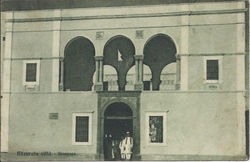 Synagogue.MisurataMost Libyan Jews lived in Tripoli, Benghazi or Misurata. Misurata is a coastal city that was officially made part of the Kingdom of Italy in 1939. Many synagogues in Moslem countries could not be easily identified from the outside. Jews didn't want to attract attention or resentment of the Moslems. Inside, the synagogues could be very plain, but sometimes they were quite beautifully designed and decorated. |
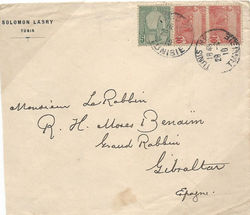 Mail to rabbiSolomon Lasry writes to the Chief Rabbi of Gibralter in 1910. |  Synagogue.Misurata.back |  Chief rabbi documentRabbi Hammus Fellah is the chief rabbi of Cyrenaica, which is the local name for the eastern third of Libya. (The NW third is called Tripolitania and the SW third is called Fezzan.) The main city is Benghazi where this certificate was signed. It states, in Italian, that Dr. Isaac Raul Fargion was born in Benghazi and is single. This would be necessary in order to get married, especially in another community. The document is also notarized by the city, with tax stamp attached. |
 Chief Rabbi FellahRabbi Fellah was also head judge of the Rabbinical court. Here he is pictured second fro the left, in traditional clothes. |  RabbiThe caption reads 'Tripoli. Rabbi'. He is studying, or posing with, an old worn Torah book. His clothing is typical for his time, place, and position. |  Rabbi to Rabbi PCR' Mordechai Cohen writes to R' A. M. Cohen (Ashkenazi chief rabbi of Cairo). He hasn't received a receipt for the 18 francs he sent. If more 1/2 shekel coupons are sent he will be able to send more money. Probably he refers to the 'Shekel' receipts that were given upon payment of dues to the Zionist organization, making them a member and giving them a vote. |
 Rabbi PC frontThe card is written in 'Rashi' style Sephardic script. It is addressed in French. The postmark reads 'Tripoli Port' and there is also a receival cancel 9 days later in Cairo. |  Libya.Jewish School to CourtThis envelope was sent from the ‘Hebrew School Talmud Torah’ in Bengasi to the Rabbinical Court on 29 June 1945. The printing is in Hebrew and Italian. Italy lost control of this area in 1943 during WWII. It was then controlled by the British. The postage stamp is a British one, overprinted ‘MEF’ (= Middle East Forces) for use in this area. On the back we can see that the letter was opened and censored; we also see the postmark and the seal of the Beit Din, in English and Arabic. |  SiddurThis Mincha/Maariv siddur was printed in Tunis Tunisia in 1908 expressly for the 'Congregation of Western Tripoli'. Tripoli is in Libya, but only a few miles to the east of Tunisia. The term 'Tripoli of the West', a translation from the Arabic, is meant to distinguish it from another Tripoli - Lebanon further East. (Tripoli means tri-cities and applies to several places in the ancient world.) One page reads: 'It is the custom in Tripoli of the west to say after Arvit as follows:'. |
 HaggadahPrinted in Tripoli in 1923. Entitled 'Eve of Passover', it includes prayers for the days before the holiday, laws of preparations, the service for the first night, and the whole Haggadah, ending with Had Gadya. Many laws and translations are presented in Judeo-Arabic, in Hebrew letters. You can see the Arabic translation of Ma Nishtana. The pages for Matzah, Morror and Korech are heavily stained - as they are in many Haggadot. |  Diploma.Shochet OfotThis diploma confers upon Yakov ben Avraham Salhoub the authority to serve as a 'Shochet Ofot' - ritual slaughterer of kosher fowl. It is carefully written by a scribe on parchment and signed by several rabbis in Trabulus. They tested his knowledge and practical skill. Dated 17 Kislev 5669 (1908). |  Diploma.Fowl & AnimalsFive months later Yaakov qualified for this Kabala (diploma) authorizing him to slaughter fowl AND animals. After the rabbis signed, he took this document to the Rabbinical court (Beit Din) of Tripoli where it was duly registered and he got their signatures of approval. |
 Beit Din SealsThese seals on the diplomas are the official stamps of rabbinic authority. The one on the right reads in Italian and Hebrew "Chief Rabbinate of Tripoli and Environs". The left one more faintly says "Rabbinical Court of Tripoli". |  Bar MitzvahThis Bar Mitzvah invitation is printed in Italian and Judeo-Arabic, in silver ink. Huato Zuares and family invite you to the event on Shabbat 20th of Av, 5699 (=1939). The Italian version calls it Communion!- a Catholic rite of Passage. The Arabic version mention Tefillin. Putting on Tefillin for the 1st time IS a celebrated event among Sepharadim -but would never take place on Shabbat, when Tefillin are never worn!? |  Young JewessThe caption reads: "From Italian Libya - A Young Jewess". She wears layers of traditional clothing and is covering most of her hair. Uncovered hair after puberty was considered a sign of a loose woman in Moslem society,even if she was single. |
 Jewish girls'Jewish Girls' reads the caption, in Italian. Although many Jews became Europeanized by Italian efforts, at this point most still dressed in the traditional style and spoke Judeo-Arabic. Most still lived in the 'Hara' (Jewish Quarter) and others returned to the synagogues there for Shabbat and holidays. Some are barefoot while others have slippers. Are they singing or dancing? |  Jewish NativesThe caption reads 'Jewish leaders from Gebel'. This may refer to mountain areas in western Libya where Jews lived among indigenous Berbers. They also live in underground homes, essentially caves, to avoid attention and increase protection. Although the picture looks posed, the impression is of native Arabian inhabitants. |  Family in DernaA family living in the coastal city of Derna, Cyrenaica. The card was mailed in 1912, not long after Italy took control. Things look calm but all that changed with the advent of WWII and after. The father's outfit is typical: knee-length shirt over white cotton pants, along black coat over all and a Fez on his head. This was the classic Libyan male outfit until the late 1920's. Others look more westernized, with ties and shorter jackets. Women and children are dressed traditionally. |
 Merchant.TripoliMoise (=Moshe) Nahum is in the business of import/export. He is based in Benghazi but the letter is postmarked Tripoli. And he is writing to Lucca Italy. Notice the postage stamp which reads 'Libia' (Italian spelling) on top and underneath says 'Italian Colony mail'. The envelope was mailed in 1918. |  Merchant.TripolitaniaThis merchant is also named Nahum. First name Vittorio, showing Italian influence. He writes to a family member in Tel Aviv - perhaps a son who made Aliyah? The stamps are British! because Great Britain occupied Western Libya in WWII and remained there until independence in 1951. They are overprinted 'B.A.' = British Administration, 'Tripolitania', and '5 M.A.L.' = Military Administration Lira, the money being used. Mailed in 1950. |  Legal mattersSent to Youseff Saadoun in Tel Aviv from the civil court in Benghazi under British control. It is a military envelope, registered and requiring no postage. Probably, Mr. Saadoun was a former resident of Libya who still had legal business, and maybe even property, there. |
 Legal business.backEven though this letter was written (February 1947) before the founding of the State of Israel, (when things got really bad), many Jews had already moved from Libya to Palestine, because of anti-Semitism, riots, and oppression. In fact, most Jews from Moslem lands lost all their wealth and have never been repaid. |  1945 riotsOn Nov 5-7 1945 a horrific attack on the Jews of Tripolitania looted, destroyed, maimed, and left 140 dead. The British administration was slow to react. R' Moshe Ostrovsky a leader of the National Council soon to govern Israel wrote this letter of condolence: ..."We express our great pain to hear of the riots...Rabbi S. Yaluz is ready to transfer to serve as your rabbi..." |  Zionist clubUnder Italian rule, the Maccabi social & sports club was established, a Zionist organization without any special ideology. Activity diminished in WWII but British forces, including Jewish soldiers from Palestine, captured the area and Zionist feelings were re-activated. Only in 1949 did the British permit emigration and the Jews responded with 'Messianic enthusiasm'. This page is from a book in the Maccabi club library. The Hebrew writing, in Solitreo, says 'Agudat Makabi Tripoli'. |
 Aliyah from ZuaraZuara is a port city in Tripolitania, west of Tripoli. About 500 Jews lived here at the turn of the century. In 1935 R' Benzion Cohen writes to ask the leaders of Agudat Yisrael if they can help him get a visa to Palestine. The nearest British consul is in Djerba, Tunisia. At this time, the British government controlled Palestine and used their power to limit and select who could enter the country. Written in Solitreo. |  Aliyah youthAfter independence, the Arab League gained in influence and Jews felt increasingly threatened, so increased their emigration. Eliyahu Wachsberger, to whom this envelope was sent, was directing Aliyat Hanoar in Tripoli in 1949-50. It is addressed to him at the 'Jewish Agency' in Italian. | 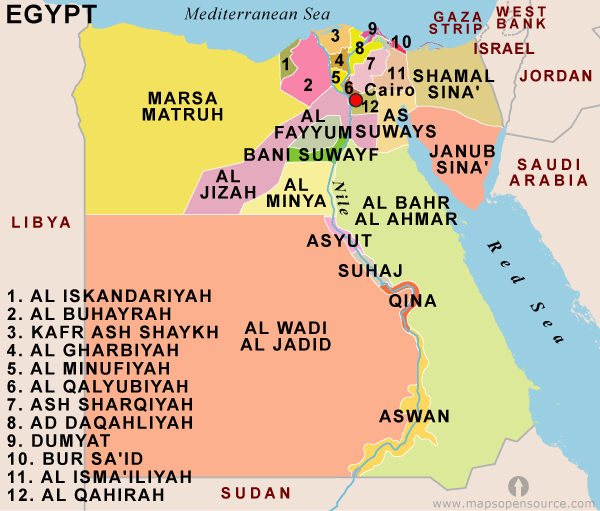 Egypt-map 1Jews returned to Egypt with the prophet Yirmiyahu at the destruction of the 1st temple and more followed, with ups and downs. After Arab conquest in 640, Jews prospered and culture & learning increased. Jews were in contact with Babylonian Yeshivot, Cairo had a Yeshiva of its own; the Rambam spent most of his life there. There was a decline under the Mamelukes in the 13th century but refugees from Spain bolstered the population and raised the standard of culture and learning. |
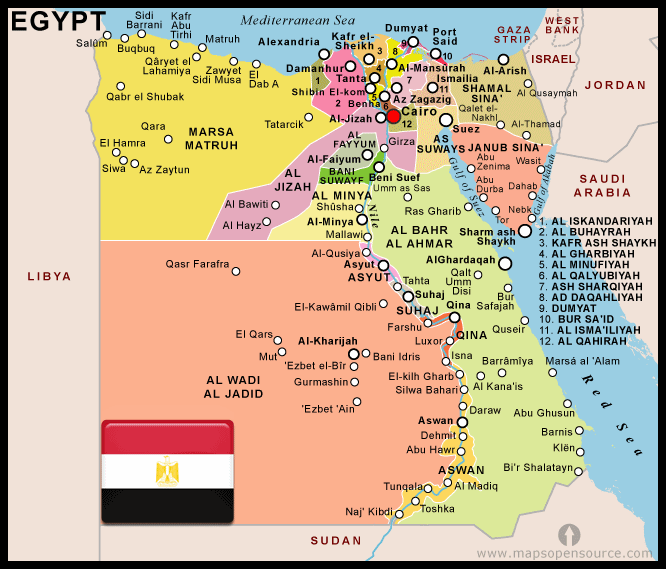 Egypt.map.2Under Ottoman rule there were 3 communities: Arab-speaking locals (Musta'arabs), Spanish immigrants (Sepharadim), and Immigrants from nearby North Africa (Mograbim). In 1768 Egypt declared independence from the Turks. In 1798, Napoleon conquered, introducing French culture. In 1882, The British occupied Egypt, and stayed until revolution in 1952. Repeated riots after 1948 led to mass emigration and a community of 80,000 dwindled to a few dozen. |  Synagogue.Alexandria.EliyahuIn the 1800's, Alexandria had a strong, thriving Jewish community. Successive emigrations have left only a handful of Jews. The magnificent Eliyahu Hanavi synagogue was built 150+ years ago, of Italian marble, and seats 700. The Aron Hakodesh holds 30 Torah scrolls. It was the last functioning synagogue in Egypt until closed in 2012. | 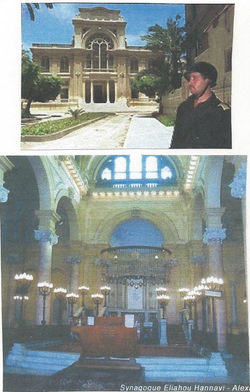 Synagogue.Alexandria.Eliyahu todayThe synagogues are now tourist sites. They are guarded by the government, but not used for services. |
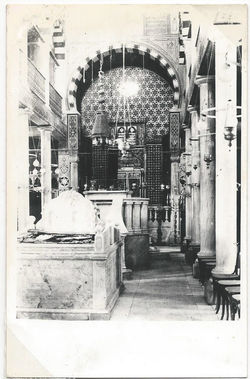 Synagogue.Cairo.Ben EzraReportedly Egypt's oldest place of Jewish worship. Legends go back to Biblical times. R' Avraham Ibn Ezra visited in 1115 c.e. and rebuilt this synagogue, which carries his name. The Genizah (worn scroll storage) of this synagogue became famous when professor Solomon Shechter discovered it for the Western world and took fragments of rare and holy manuscripts back to England to study. |  Synagogue.BenEzra.ArkThe Ark in the Ben Ezra synagogue houses over a dozen Torah scrolls in this photo. The ones in front appear to be of Sephardic style, in a case. Some are covered in metal, others in velvet. Each bears two Rimonim ornaments. The engravings probably record the names of donors. Notice that the curtain, which has been pushed to the left for this photo, is inside the doors, rather than in front of them. |  Synagogue.Cairo.KapusiRecipt for donation of 50 Egyptian grush donated by Max Porta to light a candle in memory of (father?) David Porta. April 1955. R' Hayyim Kapusi, b. 1540 & d. 1631 lived in Cairo. He lost his sight after making an unpopular ruling and declared that regaining it would prove him correct. When this happened his status as a holy man was assured. His grave is a site of pilgrimage. The synagogue is named for him. |
 Synagogue. Cairo.Sha'a HashamayimOpened in 1899, Sha'ar Hashamayim was also called Temple Ismailieh. This was the synagogue of R' Chaim Nahum, chief rabbi. It was the last functioning synagogue in Cairo, out of the original 29. This handout lists the times for High Holiday services for the year 5720/1959. The translation of the Hebrew is into French, the language of the educated and cultured Jews of Cairo. |  Synagogue.Cairo.Shaar.backAll of the main features of the service are listed, with their times. We can see Kol Nidre listed for Yom Kippur night, but it is 3rd on the list, not first. Interestingly, there is no mention of a sermon on the schedule. Perhaps people knew when to expect that from experience. |  Cairo.synagogue.Rav Moshe'Rav Moshe' is the synagogue associated with the Rambam and was named for him as he lived for a time in this part of Cairo, in the Jewish Quarter. The medieval synagogue fell into ruins in the 1960's. It was restored by the Egyptian government in 2010, and serves as a cultural site and tourist attraction. It is adjacent to the room that was his yeshiva. This image is the entrance to it. |
 Omer chart.R'Moshe synThis chart for counting the Omer between Passover and Shavuot was donated by Reuvain Moskovitz to the Congregation 'Rav Moshe'. Maimonides' synagogue was thought to have healing powers and Jews would spend the night expecting cures for their ailments. Even Egypt's King Fuad did so. |  Omer chart.backThe card bears the familiar holiday greeting "Tizku Leshanim Rabot' - may you merit to live many years. The chart shows the day of the week, Wednesday through Tuesday on the right. Then comes each day, from 1 to 49, and next to it the day of the secular month, from April 19th until June 6th. Those months are abbreviated at the top in Hebrew letters. | 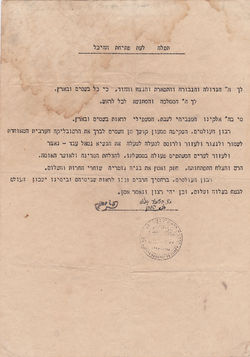 Prayer for Government & Nasser'Prayer When Opening the Ark'. This was offered on behalf of the Egyptian Government and specifies President Gamel Abd (el)Nassar. "To You G-d is the true Kingship... Master of the world shower your blessings on the United Arab Republic to guard & protect... President Gamel Abd Nassar and his ministers... Strengthen her children who guard freedom and peace...Merit us to see in our day peace and security in the world...Amen" |
 Prayer for the Government.ArabicThis is the Arabic version. This prayer follows the advice of Mishna Avot chapter 3: "Always pray for the welfare of the government...". The signatures are indistinct. The Hebrew one is signed 'Shalom Hakohen'. Both are stamped with the seal of the Chief Rabbi of Egypt which reads in Hebrew Arabic and French. |  Chief Rabbi NahumR' Hayim Nahum was a scholar of Torah and also Semitic languages. He was chief rabbi of the Ottoman Empire from 1909 until it dissolved in 1920. He became chief rabbi of Cairo, Egypt and the Sudan and served until the 1950's. He was a teacher of R' Ovadia Yosef. Here he testifies that Mary bat Nisim Benezra is single and eligible to marry. Dated 29 Iyar 5690 (1930). |  Cairo.Rabbi to rabbiThis envelope is stationery of the chief rabbi of Cairo who was R' Hayim Nahum in 1936 when it was sent. It is addressed to R' Jacob Meir, chief rabbi of Jerusalem. Rabbi Nahum's photo is added in the corner. |
 Siddur.Hebrew-ArabicUpper and middle class Egyptian Jews generally spoke a European language, such as Italian or French. Indigenous Jews and those of the Canal towns used Arabic and of course businessmen used it in daily transactions. Jewish newspapers in Arabic did not have much of a readership. This siddur has facing page Arabic translation in Arabic letters, of all the year 'round prayers. |  Siddur.Hebrew-ArabicThe title page gives much information: The siddur is called 'Siddur Parhi' after its editor Dr. Halel Yaakov Parhi. It follows the Sephardic rite and includes prayers for the whole year. It was published in 1931 by the printer Reuvain Moskovits in Egypt. |  Egypt.Ketuba.topThis wedding contract was written in March of 1944, in Alexandria (‘Na Amun’). The groom is Avraham Albert Francis & the bride is Anitas ? Arbiv. |
 Egypt.Ketubah.bottomIn addition to the financial obligations, the groom commits himself to taking no other wife and—if it comes to it—divorcing only through a proper Jewish court. Signed by (Alexandria’s chief rabbi) Moise Ventura and a Mr. Angil. The document tax was paid and the Seal of the Chief rabbi is stamped as well. |  Alexandria.Marriage licenseWhereas Saul Gabriel age 28 and Marie Benezra19, both of Alexandria, have demonstrated they are single (based in part on R' Nahum's letter) the Commission of the Jewish Community of Alexandria recommends that the chief rabbi proceed with the wedding. It is to take place on Sunday June 22, 1930. Signed by the commission officer, the secretary and the cashier. |  Alexandria.Marriage registr"On 25th Elul (15 September 1949) Yosef son of Nesim & Esther Abuhbut, and Alice daughter of Michael & Rose Weisz, were united in marriage under Rabbinic law." Registered, fee paid, signed and sealed. The rabbi is Aron Angel who officiated in Alexandria until 1958 when he emigrated to Argentina. The certificate is typed in French, the language of many educated Egyptian Jews. |
 Diploma of a ShochetThis diploma (called a kabbala) to be a ritual slaughterer was awarded to Shlomo ben Eliyahu Tzabach by the Beit Din of Alexandria. It is signed by the chief rabbi there, R' David Prato, who was an accomplished and outspoken leader. The shochet is reminded to not overstep his bounds, cooperate with other shochtim, and constantly review the laws of shechita, and conduct himself as a G-d-fearing Jew. |  Chief Rabbi Prato |  Chief Rabbis CorrespondThis envelope is from the chief Rabbi's office in Alexandria. It is printed in Italian. Mailed 22 May 1896 to Jerusalem, to Chief Rabbi Shaul Elyashar. The chief Rabbi in Alexandria then was R' Eliyahu Hazan. The words on the back, written in soletreo, are not clear but definitely say (3rd word) 'Hazan'. |
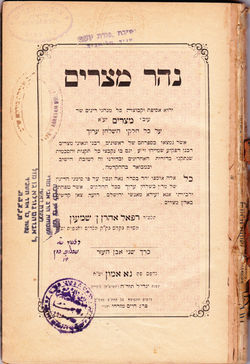 Laws & customs of EgyptThis book is a digest of laws and customs observed specifically in the Egyptian Jewish community. It is named 'Nahar Mitzrayim', literally 'River of Egypt'. Published in Alexandria in 1908, written by Aharon ben Shimon. It bears numerous impressions of seals from rabbis and institutions in Egypt and later Israel. This volume focuses on laws of wedding and divorce and includes a section on Halitzah! |  Egypt.Passport.This Is a ‘Laissez Passer - a travel document - for Daoud Ezra Mizrahi of Palestine who lives in Cairo. | 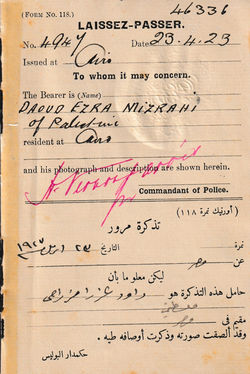 Egypt.Laissez PasserThe document identifies them for travel in 1924. British dominance, which had begun in 1882, continued even after Egypt declared independence in 1922. |
 Family IncludedIt includes Daoud/David's wife Rachel and children Fortune, Aziza, Rena, and 2 month old Moussa (Moshe). |  Coorespndance between communitiesThis is an official envelope mailed from the Jewish community in Cairo to the Jewish Community in Alexandria. These were the two largest centers of Egyptian Jews. Thousands left Egypt after the Sinai Campaign of 1956-57. The envelope is postmarked February 1967. After the 6 Day War only 4 months later, things deteriorated significantly leading to the end of Egyptian Jewry. |  Egypt.Cairo.Dues receiptThis is a receipt for dues of 2 Egyptian pounds to the Cairo Jewish community. At the bottom it explains: “The Arikha is the annual contribution to the office of the community of all Jews who reaches the age of 21, unless known to be indigent.” On the back someone wrote that the dues are 1 pound and the extra pound pays for ‘overall beautification’ for 1954. A government tax stamp appears near the bottom. |
 Hebrew bookseller.AlexandriaIn 1942, the community was thriving. Moussa (Moshe) Rossabi is comfortable using Hebrew in his business return address. He sold Jewish books and religious articles in Alexandria. Here he is writing to Jews in Tel Aviv Palestine. It is war-time so the letter was opened, checked, and resealed. Most Jews in Egypt were merchants at this time. |  Wedding DonationIt has always been a special mitzvah to provide for the wedding and home furnishings of brides who are poor. ('Hachnasat Kallah'). The label is a receipt for a donation of 5 Egyptian Milliemes to the Society of Anonymous Gifts for the Wedding of Jewish Daughters'. That legend appears in Hebrew and Arabic around the image of a coin. |  Purim Ball ticketTicket of admission to a Masked Purim Ball to be held on Saturday March 3rd, 1945. Surprises, Party Favors, Games... Purim balls were held in the USA and Europe, and were generally social affairs, sometimes also raising money for good causes. This one was held towards the end of World War II ! Admission was 50 piastres for a couple. The rubber stamp was for tax purposes. |
 Charity FestivalTicket for admission to a benefit concert 'for free education of poor children and orphans'. It will feature 'comedies and songs in French, Hebrew, Greek, and Arabic'. The presentation took place on Sunday 29 June 1941. The symbol of the school is seen in the middle and also stamped in the upper right. |  School Donation ReceiptReceipt for 20 piastres donation to the 'Joint Children's School'. The school is for the 'protection of children without regard for Race or Religion'. But it is supported by Jewish dollars. Its slogan is 'Support education to wipe out crime'. Interestingly, the receipt is also printed with New Year wishes for 5705 (1945). The school is in Alexandria. |  Gan Yeladim solicitationAnother school for poor children, Gan Yeladim focuses on the very young. This letter accompanied 2 tickets and requested a donation of 20 piastres. It is dated 2 April 1939. It was founded in 1923 by Meshulam Taram and in 1938 had 150 students ages 3 - 8. |
 Gan Yeladim.AlexandriaThe back of the kindergarten flyer shows a scene from the previous year's festival, under the patronage of the governor of Alexandria, Mohamed Hussein Pacha. |  Gan Yeladim.founderThis Gan Yeladim flyer identifies the founder. Established in 1923 by Meshulam A. Teram. |  Gan.invitationGan Yeladim also has a festival which is a fundraiser. It is the annual distribution of toys and apparel, donated by noted philanthropists. This flyer invites the recipient to attend. The admission fee is 50 piastres. |
 Gan.gameThe invitation includes a puzzle: "Eight times eight equals 65" - and describes the challenge. A solution will be provided upon receipt of a donation. |  Girls InitiationAnother charity, Chevrat Omlei Torah, provides food and clothing, apparently for older children. This card, valid for 2 guests, enables admission to 'the annual ceremony of Religious Initiation for young girls' to take place at the Eliyahu Hanavi synagogue on Sunday 16 June 1940. Perhaps this was some form of Bat-Mitzvah? A note at the bottom cautions that children under 12 are not admitted. | 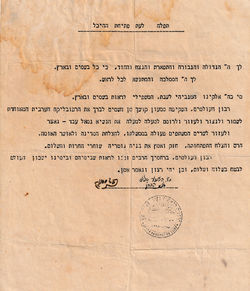 Egypt.Prayer for Govt.HebrewThis is a Prayer for the Welfare of the Government. “...Bless the United Arab Republic and preserve and elevate the President Gamal Abdul Nassar and his officers...for the success of the country and the welfare of its nation...Strengthen its sons who preserve freedom and peace ...Master of the World may we be privileged to see...a world of security and peace”. Signed by Shalom Hakohen and another, and imprinted with the seal of the Jewish community. |
 Prayer for Govt.ArabicThis is a Prayer for the Welfare of the Government by the Jewish community - in Arabic. It is also signed in Hebrew by 3 leaders of the Jewish community. One name is Solomon. Another is Mordechai. Below is imprinted the seal of the Jewish community. According to the first line, it is intended to be read at the opening of the Torah Ark. |  Cairo.merchant.HamauiThis envelope traveled from Cairo to Esna, a town on the west bank of the Nile. The return address, on top, shows that it was sent by a Jewish company named Behor Joseph Hamaui & Sons. Behor means first-born in Hebrew and was often given as an automatic title/name. | 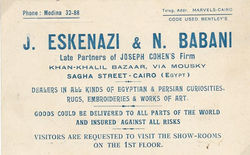 Cairo.merchant EskenaziJ. Eskenazi & N. Babani were merchants with a shop in the bazaar in Cairo. They dealt in curiosities, rugs, embroideries and works of art. The back of this large business card appears to say the same thing in Arabic. 'Eskenazi' means 'Ashkenazic person' but would only be used to describe someone who stood out with that feature, meaning that his family at some point relocated to a Sephardic community, where their origin was distinctive. |
 Cairo.merchant.Arabic |  Alexandria.business letterSent from Alexandria in the summer of 1933. Elimelech Polne writes in Hebrew to his lawyer, asking that an occupant of an apartment be evicted. He paid the necessary fees. In addition, the occupant, Baruch Segal, stills owes him the rent money. Mr. Polne was comfortable writing in Hebrew and even used it on his stationery. |  Women's clothingWomen had a number of considerations: being modest, avoiding the attention of strangers, and distinguishing themselves from non-Jews. In Moslem society all respectable women covered their bodies with a wrap or cloak and veiled their faces. Jewish women had the cloaks but as non-Moslems were 'not worthy' of the veil. (Indoor clothing was another matter - there women could wear their finest garments and jewelry). This card mailed from Cairo to Uruguay in 1906 illustrates outdoor clothing. |
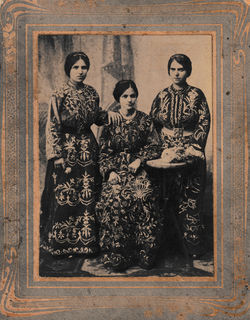 Egypt.Women's clothesThese three Egyptian women were photographed circa 1890. That was a special event and they are wearing indoor clothing. The dresses are beautiful, elaborately embroidered. |  Jewish I.D.There were 80,000 Jews in Egypt in 1940, when this Identity card was issued. They included locals, North Africans, Sepharadim, and Ashkenazim. Only a third had citizenship. the rest were foreign nationals or stateless. This card was issued to Sola Abigdor by the Kingdom of Egypt. She was born in 1877 in Cairo but her nationality is listed as Italian. The card is filled out in English, reflecting ongoing British influence in the government. |  Jewish I.D.backThe back reads 'Kingdom of Egypt' and 'Card of Identity'. There is room for Arabic entry of information. |
 Judeo-ArabicSent from Cairo to Alexandria, this card is addressed in Judeo-Arabic. Below in pencil is an Arabic address, so that it would actually go where it was sent. The writing is somewhat crude Eastern style. Perhaps the writer is from the indigenous Jews of Egypt. |  Judeo-Arabic.messageYahya ibn Harun Alshachav is writing to Yuda Moshe in Al-Iskandariya (Alexandria). Notice that he writes Yuda without a 'Hey' in order to avoid writing Yud and Hey and Vav together. |  Egypt.Zionist Organiz. AlexandriaZionism in Egypt grew after the Balfour declaration. But the disturbances in Palestine in 1929 aroused anti-Zionist/anti-Semitic feelings and Zionist activity diminished. Some Jews wanted to preserve relationships with the Arab community while others were fervently nationalist. This envelope mailed in 1933 openly describes the sender as the Zionist Organization of Alexandria - הסתדרות ציונית באלכסנדריה. |
 Zionism.donationThis is a receipt for 300 piastres from the Zionist Organization of Alexandria. That office was headed by Leon Castro in 1921. It is written in French, which was an international language before WWII. The money was directed to Vaad Hatzirim - Council of Delegates - also known as the Zionist Commission, who administered the Jewish community in Palestine after WWI and coordinated relief efforts. This money may well have been a donation for the poor. | 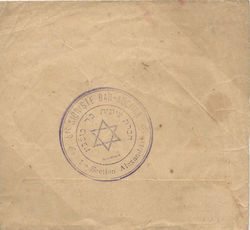 Zionist club.Bar KochbaThis newspaper wrapper bears the seal of 'Chevrat Tziyonit Bar Kochva', that is The Bar Kochba Zionist Society in Alexandria. Most Egyptian Jews were happy where they were and support was generally financial. This paper was probably mailed in the 1920' or 30's when Zionism was tolerated. All that changed after the 1948 war when life became difficult and emigration ensued. |  Egypt.Aliyah certificate.coverThis is a coveted Immigration certificate, issued by the Jewish Agency for immigration to Palestine. The British established a quota on immigration, to limit the entry of Jews to the country. They empowered the Jewish Agency to issue these certificates. People in many countries were clamoring to get them. This one went to a family in Cairo. |
 Egypt.Aliyah certificate.photo pageAvraham Arjil (Ibrahim Albert). His certificate is number 57,716. This front page is date-stamped 29 September 1934 by the 'Zionist Organization of Cairo'. | 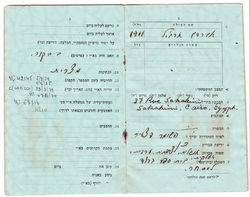 Egypt.Aliyah certificate.detailsThese pages give the birth year, 1911, and the address. He was a member of the Hashomair Hatzair Youth movement, speaks Hebrew - along with English, French, Arabic, and Italian. He completed high school, majoring in business. He had visited 'E. Israel' once. He also passed the physical exam with flying colors, as listed on the form in the back. | 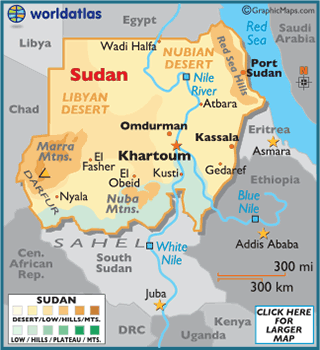 Sudan.Map |
 Sudan.Chief R' MalkaSolomon Malka 1878-1949 was chief rabbi of the Sudan for 44 years, after having been a Dayan in Tiberias. The Malka family traced its distinguished roots back to Spain. This translation of his Arabic sermons was published in English by his son. |  Album.WOS.Egypt.Prayer for Govt |  Tunisia.Ketuba.1920.face |
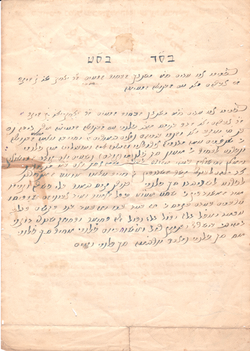 Tunisia.Ketuba.1920.back |
bottom of page